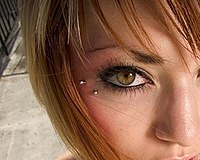
A bridge piercing is a facial piercing through the skin on the bridge of the nose, usually directly between the eyes of the wearer. A variation on this piercing, the vertical bridge piercing is a surface piercing, with all of the risks or potential complications related to surface piercings.

A navel piercing is a type of piercing that penetrates the skin of the navel. It is most commonly located on the upper fold of skin but can also be affected underneath or around the edges of the navel. Healing usually takes around 6–12 months but varies person-to-person due to differences in physiology.

An earring is a piece of jewelry attached to the ear via a piercing in the earlobe or another external part of the ear, or, less often, by some other means. Earrings have been worn in diverse civilizations and historic periods, often carrying a cultural significance.

An eyebrow piercing is a vertical surface piercing, wherein a twelve to eighteen gauge cannula needle is inserted through the bottom of the eyebrow and exits through the top of the eyebrow to permit insertion of jewelry. Those performing the piercing may use a pennington clamp to better guide the needle through the skin. A curved barbell is the most common jewelry inserted post-piercing.

A tongue piercing is a body piercing usually done directly through the center of the tongue. Since its decline in popularity around 2011, it has seen a recent upsurge making it now the second most popular piercing amongst young women aged 18-25 in 2019. It has become quite unpopular amongst men, although in the 1990s and early 2000s, it was more popular for men than women to get and associated with punk culture. Midline tongue piercings, or one hole through the center of the tongue is the most common way to have the tongue pierced.
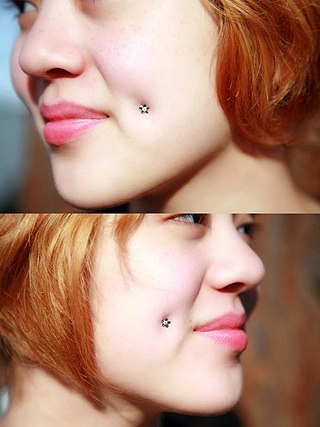
Cheek piercing is a facial body piercing through the cheek. The most common variation of the cheek piercing penetrates the facial tissue into the oral cavity. The usual placement is symmetrical on either side of the face, either penetrating or imitating dimples.

A Christina piercing, also known as a Venus piercing, is a female genital piercing. It is located where the outer labia meet, below the pubic mound. The Christina piercing is anatomy dependent; it has a high rejection rate, and is not possible for all women due to anatomical variation. If the flesh above the clitoris where the outer labia meet is fleshy enough to pinch, a Christina piercing may be successful. If the flesh in this area is too tight to pinch, a Christina piercing is contraindicated. The piercing does not facilitate sexual stimulation and can be found uncomfortable when pressure is applied. It is usually pierced with either a custom-made curved barbell or surface bar to reduce the risk of rejection.

Surface piercings are piercings that are found on flat parts of the body, giving a double-pierced look that sits flat against the skin. A surface bar follows the plane of skin, while a standard piercing is pierced through the plane. Standard piercings have an entrance hole with an exit hole that is usually directly behind the entrance hole, whereas with a surface piercing the entrance and exit holes are next to each other on the skin surface.
Body piercing jewelry is jewelry manufactured specifically for use in body piercing. The jewelry involved in the art of body piercing comes in a wide variety of shapes and sizes in order to best fit the pierced site. Jewelry may be worn for fashion, cultural tradition, religious beliefs, personal symbolism, and many other reasons.
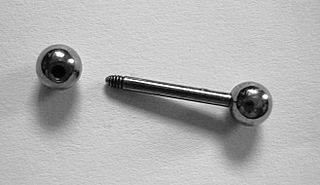
Barbell style piercing jewelry is composed of a straight bar with a bead on each end, one or both beads unscrewable for removal and/or changing of the beads. Often one of the beads is fixed, either via epoxy or welding, so that only one bead is used to install or remove the jewelry. Barbell threads are usually right-handed.
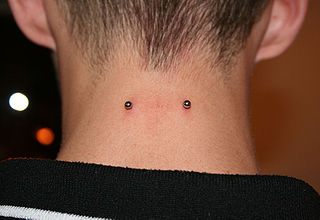
A nape piercing is a piercing through the surface of the nape of the neck. Nape piercings are a type of surface piercing. They carry a high rate of rejection and migration, unless they are properly measured and placed. They may reject if they are not pierced properly, as they are in a part of the body that moves constantly and are easy to irritate, catching on clothing or other objects.
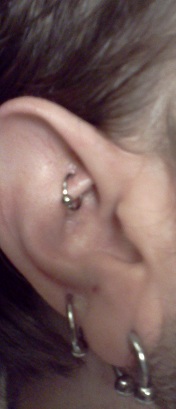
A rook piercing is a perforation of the antihelix of the ear for the purpose of wearing jewelry. It is located just above the tragus on the ridge between the inner and outer conch with the piercing passing from the underside to the top of this ridge, differing from many ear piercings that essentially span between a "front" and "back" surface. Erik Dakota, a well known professional piercer and the individual responsible for originating and popularizing the rook piercing, is said to have named this modification after a shortened version of his first name. The piercing was first named in issue #4 of the magazine Body Play and Modern Primitives Quarterly around 1992 alongside the first printed reference to the industrial piercing, then termed "industrial ear project".
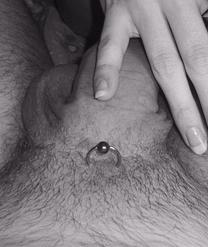
A pubic piercing is a body piercing in the pubic area. The term usually refers to a piercing at the base of the penis, making it a male analogue to the Christina. Healing times are typically around 3–4 months.. As this is essentially a surface piercing, the rejection rate is higher than most "conventional" piercings. Some get this piercing because it can offer direct stimulation to the clitoris during intercourse. Standard placement is horizontal, at the natural juncture where the bottom of the pubic mound meets the base of the penile shaft. Curved barbells are the most common initial jewellery, although a ring may be an option and many wearers replace their starting jewellery with rings once the piercing has healed. Piercings further up the pubis may also be possible, but this would not be a 'pubic piercing' as such but rather a surface piercing on the pubis. For these placements a staple-shaped surface bar would likely be used to give the best chance of healing.

A Madison piercing is a body piercing going through the skin at the front of the neck. They are surface piercings, and have a high rate of migration and rejection. They have a long healing period, if they heal at all. The Madison piercing is named after the first person publicly associated with it, the porn star Madison Stone.
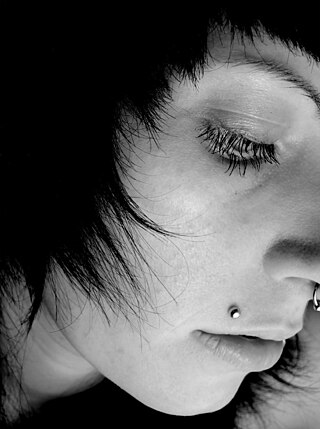
A Monroe piercing is a lip piercing placed off-center, above the upper lip on the left-hand side and is meant to resemble Marilyn Monroe's beauty spot, although Monroe's beauty spot was on her cheek, not her lip. The Madonna piercing is similar but worn on the right-hand side.
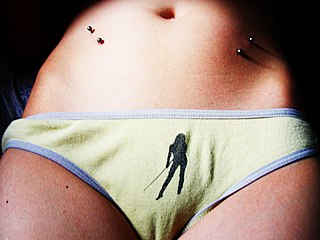
A hip piercing is a piercing in the pelvic area through the skin near the hip bone. Hip piercings are often done in couplets with one on each hip, but it is not unusual to see only one. Hips piercing are a type of surface piercing. Microdermals or skin divers can be implanted in the hip area to give a similar appearance.

In body modification, an implant is a device that is placed under the human skin for decorative purposes. Such implants may be subdermal or transdermal. In the context of body modification, some may consider injections of silicone and other substances a type of implant as well.
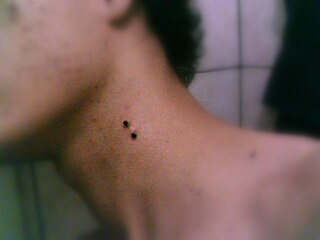
A neck piercing is a series of surface piercings done to emulate the appearance of a bite on the side of a person's neck. A barbell is placed in the skin of the side of the neck. When the earring/barbell is removed it looks like a vampire bite.
A wrist piercing is a piercing through the surface of the wrist, first popularized by Jon Cobb in PFIQ. Wrist piercings are a type of surface piercing. They carry a high rate of rejection and migration, unless they are properly measured and placed. The piercings may be rejected if they are not installed properly; due to the location of the piercings they are easy to irritate, and regularly catch onto clothing or other objects. People with wrist piercings are advised to put on short sleeved t-shirts, singlets so as to prevent the surface barbell from catching onto the threads of the clothing. Also, wrist piercings can only be done with a special tool and thus, it is of high difficulty for it to be home-made. Piercers would also advise that, after getting a wrist piercing, the person is to soak and moisten the wound with mild salted solution so as to disinfect the area, preventing bacteria from entering the unclotted wound. The span of a wrist piercing ranges approximately from as short as 2 weeks to 6 or 7 months.
